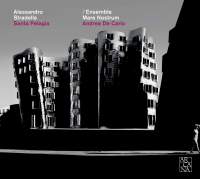Texte paru dans: / Appeared in: |
|
|
Outil de traduction ~ (Très approximatif) |
|
|
Reviewer:
Barry Brenesal
The score to Santa Pelagia
is currently sourced to just one anonymous manuscript in Modena’s
Biblioteca Estense—there perhaps as a result of a performance of the work in
the city in 1688, six years after Stradella’s death. Nothing else is known
of it, certainly not why its composer and his anonymous librettist were
commissioned to create a work that might bring to mind the Pelagini movement
of recent memory, condemned as heretical.
However, the oratorio itself
has nothing to do with Quietism—or indeed, the historical Saint Pelagia, of
whom next to nothing in any case is known. It instead uses Pelagia’s
renunciation of worldly wealth as a convenient peg upon which to hang an
allegorical contest between the World, and Religion. As both compete for
Pelagia’s acceptance, she is joined by Nonnus (Bishop Nonnus, credited with
converting her sometime during the fifth or sixth century), who helps to
gang up on the World. Though structurally and thematically similar to
Stradella’s Santa Edita, the libretto is clumsy. It has little of the
insight that Edita’s librettist, Prince Lelio Orsini, brought to
understanding the different snares which the mind and body present to a
person contemplating monastic or solitary seclusion. The World, for example,
boasts that it crowns monarchs through wars, as if this is going to somehow
convince Pelagia, a wealthy and popular actress, to set aside all thought of
worldly renunciation. Musically, it concentrates on very short recitatives and arias, with the exception of a duet and a short contrapuntal chorus of the worldly. With most selections lasting around a minute and a half or less, the emphasis is on moving the story ahead rather than allowing characters to dwell on their arguments. Stradella, a musical conservative in many respects, produced an enchanting score of simple, expressive melodies that bring to mind Cavalli’s operas, such as Artemesia and L’Ormindo. Yet where a more serious and musically complex treatment might be thought worthier of the work’s religious subject, the composer’s attractive themes and their unadorned treatment paradoxically bring the evanescence of the world front and center. Lacrimae rerum, not Santa Pelagia’s Nonnus and Religion, may well supply the oratorio’s path away from the World.
Some time ago I reviewed a
recording of Andrea De Carlo and his Ensemble Mare Nostrum in Stradella’s
Santa Edita (Arcana 396; Fanfare 40:2), a finely conceived performance
that was hobbled by inadequate singing. Not so, here: The central role of
Pelagia, heard in 13 of the 26 arias, is taken by soprano Roberta Mameli.
She was the best vocalist in an outstanding recording several years ago of
Artemesia (Glossa 920918; Fanfare 35:4). Mameli possesses a fine-grained
flicker vibrato, thoroughly blended registers, first-rate agility, and an
ability to convey vividly a theatrical experience through musical means.
Selecting among her arias for favorites is like choosing only one chocolate
from a box. “Quanto è dolce con due guardi” is softly sung and delicately
flirtatious; “Si, peccai, ma questo fonte” is penitent and gently varied in
the colors of its more melismatic passages. “Corran nettare I ruscelli” is a
short but good example of her ease with fioritura. There’s less to the other parts, but they’re generally handled well. Sergio Foresti makes a convincing World, delivering the moderately fast passagework of “È follia pugnar con gli astri” with distinction. Male alto Raffaele Pe demonstrates exquisite phrasing, fine agility, and excellent control of dynamics in “Quanto crudo il nume ignudo.” Luca Cervoni unfortunately has trouble managing even light passagework, but otherwise possesses a bright, even tone and good enunciation. Andrea De Carlo’s Ensemble Mare Nostrum is a small group, just nine musicians. Usually only a few are playing at any time, giving the music a more suitably intimate feeling than the outsized orchestral forces (including brass) employed by Maurizio Forneri and I Musici di Santa Pelagia on their recording of the oratorio issued in 2008 (Stradivarius 33792; Fanfare 32:2). Ron Salemi praised its vocal forces, save for countertenor Alessandro Carmignani’s Religion. I find Walter Testolin less steady than Foresti, however, and Laura Antonaz, although she sings well, lacks both the vocal beauty and expressive detail of Mameli. The length of the disc is admittedly far too short, but the combination of music and performance should please listeners who enjoy mid-17th-century Venetian-style opera and oratorio. | |
|
Support us financially by purchasing this disc from eiher one of these suppliers. Un achat via l'un ou l'autre des fournisseurs proposés contribue à défrayer les coûts d'exploitation de ce site. |
|
|
|
|
|
Cliquez l'un ou l'autre
bouton pour découvrir bien d'autres critiques de CD |
|




